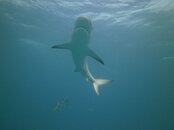Semi on topic:
One of the biggest stressors for me when I was still training NAUI in 2004 was the reg recovery. It was the single biggest source of "bolters". I would watch a kneeling student throw the reg back, a stream of little bubbles from their lips as advertised.
Often I would see that the reg had landed in an odd position, or that on the first sweep they would not touch their leg and miss the reg. By the second attempt I was holding a reg in their face because they would be starting to panic and getting ready to "Polaris" their way out.
All of this with a perfectly serviceable regulator secured to them 6 inches from their mouth.
I could never understand why the procedure was not simply to switch to the other reg, find the primary and switch back. No pressure no worries.
When I did my RAID crossover, I did the reg retrieval neutral as per the old way. Once done, my IE asked me why i didn't just switch to the necklace backup. Turns out RAID teaches that step 1 is get a reg in your mouth, breathe, then go from there. This builds muscle memory for any reg removal.
Imagine someone swimming along and they get mugged for gas from behind. They then proceed to do a reg retrieval blowing little bubbles until they realize that the reason its gone is that its in someone's mouth? Nope.
Stop. Breathe. Think. Breathe. Plan. Breathe. Act.
One of the biggest stressors for me when I was still training NAUI in 2004 was the reg recovery. It was the single biggest source of "bolters". I would watch a kneeling student throw the reg back, a stream of little bubbles from their lips as advertised.
Often I would see that the reg had landed in an odd position, or that on the first sweep they would not touch their leg and miss the reg. By the second attempt I was holding a reg in their face because they would be starting to panic and getting ready to "Polaris" their way out.
All of this with a perfectly serviceable regulator secured to them 6 inches from their mouth.
I could never understand why the procedure was not simply to switch to the other reg, find the primary and switch back. No pressure no worries.
When I did my RAID crossover, I did the reg retrieval neutral as per the old way. Once done, my IE asked me why i didn't just switch to the necklace backup. Turns out RAID teaches that step 1 is get a reg in your mouth, breathe, then go from there. This builds muscle memory for any reg removal.
Imagine someone swimming along and they get mugged for gas from behind. They then proceed to do a reg retrieval blowing little bubbles until they realize that the reason its gone is that its in someone's mouth? Nope.
Stop. Breathe. Think. Breathe. Plan. Breathe. Act.





